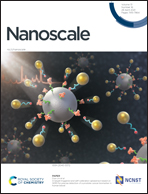2D conductive MOFs with sufficient redox sites: reduced graphene oxide/Cu-benzenehexathiolate composites as high capacity anode materials for lithium-ion batteries†
Abstract
As a superconductive metal–organic framework (MOF) material, Cu–BHT (BHT: benzenehexathiol) can exhibit outstanding electrochemical properties owing to the potential redox reactions of the cuprous ions, sulfur species and benzene rings of Cu–BHT, but its compact texture limits the specific capacity of Cu–BHT. To improve the dense feature of Cu–BHT, rGO/Cu–BHT (rGO: reduced graphene oxide) composite materials are fabricated via a facile route and they exhibit applicable conductivities, improved lithium ion diffusion kinetics compared to pristine Cu–BHT, and sufficient redox sites. The rGO/Cu–BHT composite materials maximize the potential capacity of Cu–BHT, and the rGO/Cu–BHT 1 : 1 material achieves outstanding reversible specific capacities of 1190.4, 1230.8, 1131.4, and 898.7 mA h g−1, at current densities of 100, 200, 500, and 1000 mA g−1, respectively, superior to those of pristine Cu–BHT and rGO. These results present the promising future of 2D conductive MOFs as functional materials for energy storage, based on the regulation of electronic conductivity, redox sites, and lithium ion diffusion kinetics.



 Please wait while we load your content...
Please wait while we load your content...